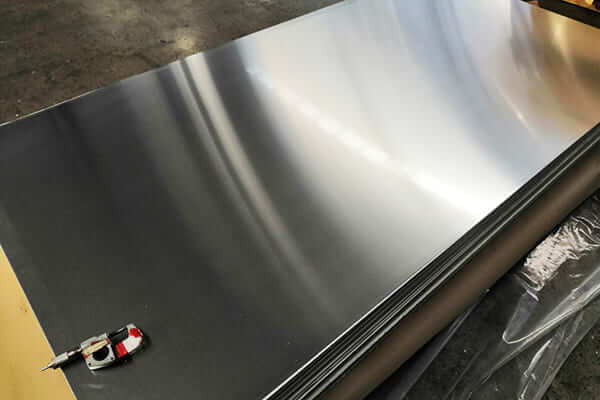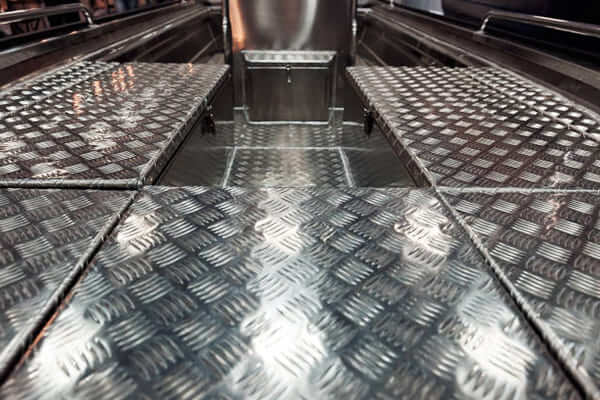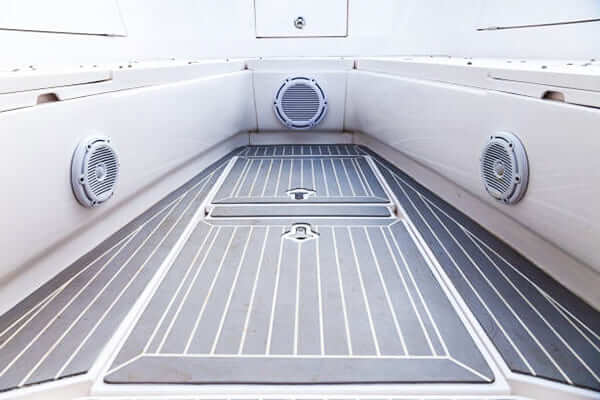Avoid rot, heavy maintenance, and slippery surfaces—opt for aluminum sheets for boat decking and enjoy decades of reliable performance with minimal upkeep.
Boat owners and naval architects recognize that aluminum sheets for boat decking deliver unmatched performance in marine environments.
Decking materials must endure constant UV exposure, saltwater spray, and heavy foot traffic.
Dahil dito, specifiers increasingly favor aluminum over traditional substrates such as teak, composite, or steel.
Beyond its corrosion resistance, aluminum offers a superior strength-to-weight ratio that enhances vessel stability and fuel efficiency.

Aluminum Sheets for Boat Decking
When you choose aluminum sheets for boat decking, alloy choice dictates long-term performance:
| haluang metal | Mg (%) | Si Si (%) | Key Benefit | Marine-Grade Spec | Karaniwang Paggamit |
|---|---|---|---|---|---|
| 5052 | 2.2–2.8 | ≤ 0.25 | Excellent pitting resistance | DNV-GL: ≤ 3 % Mg* | Light-duty deck panels, interior liners |
| 5086 | 3.5–4.5 | ≤ 0.25 | Superior seawater resistance | ABS nga ba: Min 3.5 % Mg, H116 | Primary deck plating, offshore walkways |
| 5754 | 2.6–3.6 | ≤ 0.40 | Enhanced formability & weld-ability | Lloyd’s: ≥ 2.7 % Mg, H321 | Complex curved decking, tight-radius bends |
| 6061-T6 | 0.8–1.2 | 0.4–0.8 | High structural strength | .ISO 9001 certified mills | Load-bearing deck sections, mounting bases |
*DNV-GL allows magnesium up to 3 % for general marine alloy classification.

Huawei 5086 Aluminum Sheet for Boat Decking
Ang temper designation (hal., -H32, -H116, -T6) indicates the mechanical and thermal treatments the aluminum has undergone, which significantly affect its properties:
The decision to use aluminum for boat decking brings a multitude of compelling advantages.
Marine-grade aluminum alloys possess an excellent strength-to-weight ratio.
Halimbawang, 5083-H116 can have an ultimate tensile strength of over 300 MPa (44 ksi).
This allows for robust deck structures that can withstand significant loads from passengers, mga kagamitan, and dynamic sea forces, ensuring long-term structural integrity.
Aluminum is approximately one-third the density of steel (sa paligid 2.7 g/cm³ vs. 7.85 g/cm³ for steel). This significant weight saving translates to:
Unlike wood decking which requires regular sanding, sealing, and varnishing, or fiberglass which can suffer from gel coat crazing or osmosis, aluminum decking is remarkably low maintenance.
Hindi ito nabubulok, warp, splinter, or succumb to insect infestation. Routine cleaning with fresh water and mild soap is typically all that is required.
When the correct marine-grade alloy is chosen and properly installed (addressing galvanic corrosion, halimbawa na lang), an aluminum deck can last the lifetime of the vessel.
Its resistance to UV degradation, temperature extremes, and physical impact contributes to its enduring performance.
While aluminum is known for its corrosion resistance, understanding the nuances in a marine setting is crucial.
Saltwater, rich in chloride ions, can be aggressive towards many metals. Para sa aluminyo, the main concerns are:
Proper alloy selection (tulad ng 5083 o 5086) significantly mitigates these risks.
To further enhance protection, lalo na para sa 6000 serye aluminyo alloys or in particularly aggressive conditions:
Galvanic corrosion occurs when dissimilar metals are in electrical contact in the presence of an electrolyte (like seawater).
Aluminum is anodic (less noble) to many common marine metals like stainless steel, tanso, at tanso. Prevention includes:
Aluminum sheets are produced by hot and cold rolling processes to achieve the desired thickness and mechanical properties.
Typical thicknesses for boat decking range from 3mm (1/8 pulgada) to 6mm (1/4 pulgada) o higit pa, depending on the boat’s size, support structure span, and expected loads.
Tight thickness tolerances (hal., as per ASTM B209) are essential for consistent structural performance.
To enhance safety and aesthetics:
When selecting aluminum sheets for boat decking, various types offer distinct advantages based on functionality, kaligtasan, at mga estetika.
Below are the primary types of aluminum sheets utilized in marine applications:
Flat aluminum sheets serve as the foundational material for many boat decks.
They provide a smooth and even surface that is easy to walk on and maintain.
These sheets are versatile and can be cut to size for custom applications, making them ideal for a wide range of boat designs.
Aluminum tread plates feature raised patterns, such as diamonds or checkerboards, which enhance traction and minimize the risk of slipping, especially in wet conditions.
This type is particularly popular in high-traffic areas of a boat, such as the cockpit or entry points, where safety is paramount.

Aluminum Tread Plate for Boat Decking
Perforated aluminum sheets have holes punched into them, allowing for drainage and airflow.
This feature is beneficial in environments where moisture management is crucial, as it helps prevent water pooling on the deck.
These sheets are often used in areas that require ventilation or drainage, maintaining safety and comfort.
Specialized extrusions and planks are pre-formed aluminum components designed for specific applications.
These can include interlocking planks or custom shapes that fit particular boat designs.
This type provides enhanced structural integrity and can integrate seamlessly with the overall design of the vessel.
While less common than other types, expanded metal aluminum sheets offer a unique combination of strength and ventilation.
These sheets are made from aluminum that has been slit and stretched, creating a mesh-like structure.
They provide adequate footing in non-slip applications and can be used in areas where drainage is necessary.
Ensuring the quality and suitability of aluminum sheets for marine applications relies on adherence to recognized standards and rigorous testing.
For commercial vessels or larger yachts built to class, the aluminum materials and fabrication must often meet the specific rules and requirements of classification societies like the American Bureau of Shipping (ABS nga ba), DNV, or Lloyd’s Register.
These societies provide guidelines on approved alloys, strength calculations, and welding procedures.

Wooden Boat Decking
| Tampok | Aluminyo (Marine Grade) | Kahoy (hal., Teak, Marine Plywood) | Fiberglass (FRP/GRP) | Marine Composites (hal., PVC-based, WPC) |
| Corrosion/Rot Resistance | Napakahusay | Susceptible to rot & pests (unless high-quality teak, well-maintained) | No rot (but risk of osmosis/blistering in core if damaged) | Generally good to excellent against rot & pests |
| Timbang | Magaan ang timbang | Katamtaman (Plywood) to Heavy (Teak) | Katamtaman | Moderate to Heavy |
| Ratio ng Lakas sa Timbang | Napakahusay | Mabuti na lang (Teak) to Fair (Plywood) | Mabuti na lang | Iba-iba ang, can be good |
| Durability/Longevity | Napakataas na | Mabuti na lang (Teak, with maintenance) to Fair (Plywood) | Mabuti na lang | Good to Very Good |
| Maintenance Requirements | Mababa ang | Mataas na (Teak requires oiling/sealing; Plywood needs sealing/painting) | Katamtaman (gelcoat care, buli na) | Low to Moderate |
| Initial Cost | Katamtaman hanggang sa Mataas | Katamtaman (Plywood) to Very High (Teak) | Katamtaman | Katamtaman hanggang sa Mataas |
| Epekto ng Paglaban | Napakahusay | Fair to Good (can dent/splinter) | Mabuti na lang (can crack/craze) | Good to Very Good |
| Paglaban sa Sunog | Non-Combustible | Combustible | Fire-retardant grades available, but base resin is combustible | Iba-iba ang, some are fire-retardant |
| Heat Retention (Sun) | Can be High (if bare & dark) | Mababa ang (Teak) to Moderate | Katamtaman | Generally Low to Moderate |
| Slip Resistance | Mabuti na lang (with tread plate or coatings) | Napakahusay (Teak, natural texture) | Mabuti na lang (with molded non-skid texture) | Good to Excellent (designed textures) |
| Repairability | Mabuti na lang (weldable, patchable) | Fair to Good (can be complex) | Fair to Good (gelcoat/resin repair) | Iba-iba ang, can be difficult to match/repair seamlessly |
| Aesthetics | Modern, Pang industriya (bare); Can be coated/covered for various looks | Traditional, Warm, Natural | Sleek, Moldable, Gelcoat finishes | Can mimic wood; various colors/textures |
| Recyclability | Napakahusay (100% pwede na ba mag recycle) | Renewable (if sustainably sourced); Biodegradable (untreated) | Limitado, energy-intensive to recycle | Limitado, often difficult to separate components |
| Thermal pagkakabukod | Mga Maralita (conducts heat/cold) | Mabuti na lang | Mabuti na lang | Mabuti na lang |
| Acoustic Insulation | Mga Maralita (can be noisy) | Mabuti na lang | Fair to Good | Fair to Good |
Key Considerations from the Comparison:
Aluminum sheets for boat decking represent a technologically advanced and highly practical solution for the modern marine industry.
The careful selection of marine-grade alloys, such as the robust 5xxx series or high-strength 6xxx series, coupled with appropriate design, fabrication, at mga paggamot sa ibabaw, results in decks that are exceptionally durable, magaan ang timbang, low-maintenance, and resistant to the relentless marine environment.
While the initial investment might be considered, the long-term benefits in terms of longevity, kaligtasan, and reduced upkeep often make aluminum the most cost-effective and reliable choice over the lifespan of the vessel.
As boat building continues to evolve, aluminum decking will undoubtedly remain a preferred material for those seeking peak performance and enduring quality.
A: Alloys from the 5xxx series, partikular na ang 5083-H116 o 5086-H116, are generally considered best for saltwater applications due to their superior corrosion resistance and strength.
5052-H32 is also a good, more formable option for less structural decking components.
A: Typical thicknesses range from 3mm (approx. 1/8″) to 6mm (approx. 1/4″), but this depends heavily on the boat’s size, the span between support structures, and the expected load. Engineering calculations are necessary for specific applications.
A: Oo nga, bare aluminum can become quite hot. This can be managed by applying light-colored marine paints or coatings, using deck coverings like marine carpet or synthetic teak, or by ensuring adequate shade.
A: Isolate the stainless steel fasteners from the aluminum using non-conductive materials such as nylon or Teflon washers and sleeves, and by applying a barrier compound like Duralac or Tef-Gel to the threads and contact surfaces.
A: Aluminum tread plate provides excellent built-in slip resistance. Gayunpaman, other options include applying specialized non-skid paints, adhesive non-slip tapes, or synthetic decking materials over flat aluminum sheets. The best choice depends on aesthetics, aliw, and maintenance preferences.
3005 aluminyo plate ay kabilang sa Al-Mn haluang metal. Ang lakas ng 3005 aluminyo plate ay tungkol sa 20% mas mataas pa sa ng 3003 plato ng aluminyo, at mas maganda rin ang resistensya ng corrosion nito.
Ang mga disc ng Huawei Aluminum aluminum ay malawak na na export sa Ghana, Guatemala, Burkina Faso, Algeria, Togo, Kenya, Nigeria, Timog Aprika, Morocco at iba pang mga bansa sa Africa; ang United Arab Emirates, Yemen, Qatar, Kuwait, Iran, Jordan, Saudi Arabia at iba pang bansa sa Gitnang Silangan.
1100 Ang aluminyo sheet ay isa sa mga kinatawan ng 1 serye purong aluminyo plate, at ito rin ang pinaka malawak na ginagamit na haluang metal.
Aluminyo haluang metal 8011 aluminyo foil ay malawakang ginagamit sa aluminyo-plastic composite board base tape at pagkain packaging. Bilang isang propesyonal na aluminyo foil 8011 tagagawa sa China, Ang Huawei Aluminum ay may malaking 8011 aluminyo foil produksyon base at ay naipon higit sa 20 taon ng mayaman na karanasan sa produksyon ng aluminyo foil at bihasang teknolohiya sa pagproseso.
Aluminum foil, Kilala rin bilang aluminyo honeycomb core, ay isang uri ng magaan na core materyal na ginawa mula sa dalawang layer ng aluminyo foil na bonded magkasama sa isang paraan na lumilikha ng isang serye ng mga hexagonal cell, tulad ng isang pulot-pukyutan.
6061 aluminyo likawin" ay isang aluminyo haluang metal na karaniwang ginagamit para sa mga application tulad ng automotive at aerospace components, pati na rin para sa konstruksiyon at mga produktong pang industriya. Ang artikulong ito ay galugarin ang Mga Katangian,Mga Benepisyo at Aplikasyon ng 6061 aluminyo likawin, mula sa hilaw na materyal na anyo nito hanggang sa tapos na produkto.
No.52, Dongming Road, Zhou Zhengzhou, Henan, Tsina
Henan Huawei Aluminyo Co., Ltd, Isa Sa Ang Pinakamalaking Aluminum Supplier Sa China Henan,Kami ay Itinatag Sa 2001, At Mayroon kaming mayaman na karanasan sa pag-import at pag-export at mataas na kalidad na mga produkto ng aluminyo
Mo – Sat, 8SA – 5PM
Linggo: Username or email address *
© Disclaimer © 2023 Henan Huawei Aluminium Co., Ltd
Pinakabagong Mga Komento
Mahal na Sir, Please offer your best FOB Prices specs are as under ALUMINIUM STRIP (AL=99.50% MIN) SUKAT:450 X32 X6 MM. DIN EN 570 EN-AW 1050 A, QUANTITY=3400KG
Hello po, Gusto mo bang maging kaya mabait upang mag alok ng item tulad ng sumusunod: Coil 0,6х1250 (1000)mm EN AW-3105 5tons
Hello po, Maaari mo bang i alok sa akin ang mga plato ng Aluminium? Actally kailangan ko: 110mm x 1700mm x 1700mm 5083 H111 - 21 pcs Next year planed is 177 mga pc
Mahusay na artikulo. natuwa naman ako, na search ko ang article na ito. Maraming tao ang tila, na mayroon silang maaasahang kaalaman sa paksa, Ngunit ito ay madalas na hindi ang kaso. Kaya ang aking kaaya ayang sorpresa. Bilib na bilib ako. Tiyak na irerekomenda ko ang lugar na ito at i drop sa pamamagitan ng mas madalas, para makakita ng mga bagong bagay.
kinakailangan ng aluminium strip